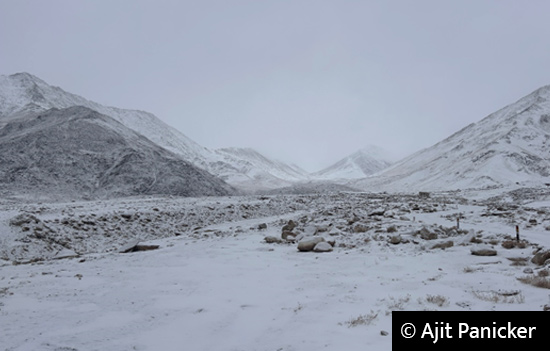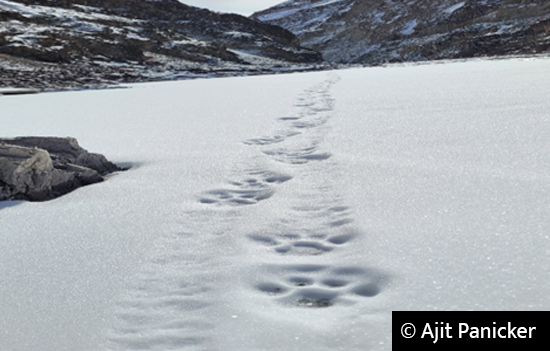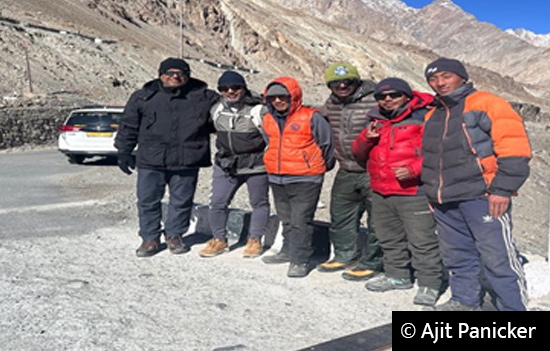- This adventure
of a life time delves into the challenges and revelations encountered on the
frozen Zanskar River, offering a glimpse into its profound impact on my
perspective and understanding of resilience, simplicity, and the natural world.
I share
my journey through the icy realms of Ladakh. This personal account delves into
the challenges and revelations encountered on the frozen Zanskar River,
offering a glimpse into the profound impact of this adventure on my perspective
and understanding of resilience, simplicity, and the natural world.
The Chadar Trek is one of the most
unique and challenging treks in the Himalayas, taking place in the Ladakh region,
India. This trek involves walking on the frozen Zanskar River during the winter
months, typically from January to February, when the temperatures can drop to
as low as -30°C (-22°F). The trek spans approximately 105 kilometres (65 miles) round trip, and it usually takes
about 7 to 9 days to complete.
The word "Chadar" refers to the blanket or sheet of ice that forms over the river, creating a walkable path for the trekkers and the local Zanskar people who have used this route for centuries to travel during the harsh winters.
This
10-day expedition which we chose, starting on February 3, 2024, encompasses a
blend of rest, acclimatization, and trekking from Leh to various locations such
as Tsogsti, Sumdah, Chilling, Skiu, and Markha, before returning to Leh.
Embarking on the Chadar Trek as outlined in the itinerary was an adventure of a lifetime, blending the raw beauty of Ladakh's winter landscape with the warmth of local hospitality. The journey, which spanned from February 3rd to February 12th, 2024, was not just a physical challenge but a deep dive into the cultural heartbeat of the Zanskar region.
The Plan
Arrival in Leh: The trek began with our
arrival in Leh, where we spent the initial days acclimatizing to the high
altitude. Leh, with its serene monasteries and vibrant markets, offered a
gentle introduction to the rugged terrain that lay ahead. The rest days were
spent visiting local sights, allowing us to soak in the rich heritage and
prepare mentally and physically for the trek.
 In main market Leh.
In main market Leh.
Trek Commences
The actual trek started with a drive to
Sangam, followed by a trek to Tsogsti. The transition from the bustling town to
the serene landscapes was immediate and breathtaking. The frozen vistas of the
Zanskar River, flanked by towering, snow-clad mountains, were a remarkable
sight.
 Drive to Sangam – is where the Indus and Zanskar rivers meet.
Drive to Sangam – is where the Indus and Zanskar rivers meet.
Journey through the Frozen
River
Trekking from Tsogsti to Sumdah and then
onto Chilling was an exhilarating experience. Walking on the frozen river, with
the ice beneath our feet and the clear, blue sky above, was surreal. Each day
presented new challenges - from navigating through ice sheets to adjusting to
the biting cold. Yet, the stunning landscapes made every hardship worthwhile.

Skiu to Markha
The trek from Skiu to Markha was the highlight of the journey. The trek's difficulty level escalated, but so did the scenic beauty. The Markha Valley, with its quaint villages and ancient monasteries, offered a glimpse into the traditional Ladakhi way of life, untouched by time.

Return to Leh
The return trek to Chilling and the
subsequent drive back to Leh was a time of reflection. The landscapes began to
feel familiar, yet each vista revealed something new. Back in Leh, we had a
reserve day, which was a welcome break to rest and relive the memories created
over the past week.
Challenges
of the Trek
The Chadar Trek presents several
challenges that evaluate the physical and mental fortitude of its participants.
Here are some of the key challenges experienced during this trek:
1. Extreme
Cold: Temperatures can plummet to -30°C (-22°F) or lower, especially during the nights. Coping with such extreme cold requires proper gear, acclimatization, and mental preparedness.
While on the Trek, as a trekker you layer
up to manage the cold. However, while you trek on the river under the sun, you
begin to sweat and often our thermal would be soaked in sweat. While you may
remove a layer but when your trail gets into a shade the temperature drops
dramatically. That makes it tough when you face the fast changing temperatures.

2. Unpredictable
Ice Conditions: The condition of the ice on the Zanskar River can vary,
from solid, thick sheets to fragile, thin layers overflowing water. Assessing
and navigating these conditions safely is a constant challenge. There were time
when we did set our foot on a weak ICE and the Ice did give way below your feet
and that is an experience gripped with fear. Fortunately the trekking poles and
your colleagues help you to get to the banks and the challenge is to change
your wet pants and clothes to a new one to avoid a frost bite.

3. High
Altitude: The trek takes place at a high altitude, with Leh itself situated
at over 3,500 meters (11,500 feet) above sea level. The risk of altitude
sickness is significant, necessitating proper acclimatization and monitoring
for symptoms.
4. Physical
Endurance: Walking on ice, often in heavy boots and with a backpack, is
physically demanding. The trek requires good physical fitness and endurance to
manage long walking hours under harsh conditions.

5. Limited
Resources: The remote nature of the trek means that resources are limited.
Access to medical facilities, for instance, is minimal, and trekkers must be
prepared to manage with what they have.

6. Accommodation
and Sanitation: Accommodations during the trek are basic, ranging from
tents to homestays in remote villages. Adapting to simple living conditions and
limited sanitation facilities can be a challenge for many.
7. Diet
and Hydration: Keeping adequately nourished and hydrated is crucial, yet
challenging, due to the cold. The body requires more calories in such
conditions, and the cold can reduce the desire to eat and drink.

8. Mental
Fortitude: Beyond the physical challenges, the mental aspect of enduring prolonged
periods of discomfort, isolation from usual comforts, and the monotony of the
icy landscape can be taxing.

9. Environmental
Stewardship: The trek underscores the importance of conscientious travel, as we traverse a delicate ecosystem. The principle of 'leave no trace' is paramount, coupled with adherence to local conservation guidelines, adding a vital dimension of responsibility to our adventure. A serendipitous encounter with the paw prints of a snow leopard along our path was a stark
reminder of the wild inhabitants sharing this terrain with us. Although the
elusive creature remained unseen, its presence was felt, highlighting the need
for respectful coexistence with these rare beings in their natural habitat.

10. Cultural
Sensitivity: Navigating the cultural landscape, respecting local customs,
and interacting appropriately with the Indigenous communities require awareness
and sensitivity.

Key Life Learning’s
The Chadar Trek, a journey across the
frozen Zanskar River in Ladakh, is not only a test of physical endurance but
also a profound teacher of life lessons. Here are some invaluable insights that
one can gain from this extraordinary trek:
1. Resilience
in the Face of Adversity: The harsh conditions of the trek, with extreme
cold and unpredictable ice, teach the importance of resilience. Learning to
push forward despite difficulties is a valuable skill that applies to various
life situations.
2. Adaptability: The ever-changing conditions of the frozen river necessitate quick thinking and adaptability. This mirrors life's unpredictable nature, where being flexible and open to change is crucial for overcoming obstacles.
3. Appreciation
for Nature: The pristine beauty of the Himalayas, the frozen waterfalls,
and the stark yet beautiful landscapes foster a deep appreciation for nature.
It serves as a reminder of the importance of preserving our natural environment
for future generations.
4. Embracing
Simplicity: The essence of life in Ladakh's remote corners is a testament to the beauty of simplicity, a stark departure from the complexity of modern existence. The local way of life, defined by minimalism and a focus on essentials, offers profound lessons on living meaningfully. While the concepts of minimalism and simplicity are often discussed, experiencing them firsthand amidst the serene landscapes of Ladakh can be transformative, challenging us to reconsider our priorities and the true essence of contentment.
5. Community
and Teamwork: The trek was undertaken in a group of four, and the harsh
conditions necessitate mutual support and cooperation. This experience
reinforces the value of community and the strength found in working together
towards a common goal.
6. Mindfulness
and Present Moment Awareness: The need to be constantly aware of the ice's condition underfoot fosters a heightened state of mindfulness. This practice of being fully present can enhance daily life, reducing stress and increasing contentment.
7. Personal
Growth and Self-Discovery: Facing and overcoming the challenges of the Chadar Trek can lead to significant personal growth. It is an opportunity to evaluate one's limits, confront fears, and discover inner strengths that were previously unknown.
8. Respect
for Culture and Tradition: The trek offers insights into the lives of the
Zanskari people, who navigate this frozen river as part of their daily lives
during the winter months. This fosters respect and appreciation for diverse
cultures and their adaptation to their environments.
Support Team
Our Chadar trek was supported by an
efficient support team, which had a local lead trekker who is familiar with icy
terrain especially in checking the strength of the Ice with the flowing river
under it. Along the road is a vehicle with all the food, sleeping bags, our
personal baggage with a skilled driver, a cook, and a helper. They are given
fixed meeting points during the trek where we would get food and refreshments
during the day and at night.

Incredible India
India's diversity is vividly encapsulated in the Chadar Trek, a unique adventure across Ladakh's frozen Zanskar River. This trek highlights India's natural beauty, from the serene Himalayan landscapes to the challenging icy terrains.
It also offers a deep dive into the rich cultural tapestry of Ladakh, highlighting the resilience and simplicity of its people. The spiritual sites along the route reflect India's profound spiritual heritage, adding a serene dimension to the adventurous journey.
Moreover, the trek underscores the importance of environmental conservation, resonating with India's commitment to sustainability. The Chadar Trek mirrors the incredible experiences India offers, blending adventure, culture, spirituality, and ecological awareness in one remarkable journey.

Author Ajit Panicker, with over twenty years of entrepreneurial experience, leads as the CEO of Nova HVAC Systems India and is the driving force behind the tech startup Pureblu. Pureblu stands out for its innovative IT and IoT solutions tailored specifically for the HVAC&R industry.
Beyond his professional achievements, Ajit is an enthusiastic marathon runner and an enthusiastic trekker, with a tradition of exploring the Himalayas annually for the last decade. His insights extend into the digital realm with his third podcast series, "Life.EV." This weekly podcast delves into the exploration of values in life and is available on all prominent podcast platforms.
Social
Media Handles
LinkedIn:
appureblu
Facebook:
AjitPanickerMumbai
Instagram: @ajit. panicker
X (twitter):
@ApMumbai
YouTube: @Pureblu
Spotify
Article is copyright author. Written approval from esamskriti is required to re-publish this piece.
Also
see in Ladakh
1. Pangong Lake
2. Tso Moriri Lake
3. River rafting
Zanskar river
4. Palaces Leh
5. Hall of Fame, Leh – Army Museum
6. Journey to
Phuktek Monastery, Zanskar
7. Khardungla Pass
8. Sand Dunes,
Nubra Valley
9. Thiksey
Monastery
10. Hemis Monastery
11. Stargazing in
Ladakh
12. Photography tour
to Zanskar
13. Drive Leh to
Zanskar
14. Drive Leh to
Kargil
15. Turtuk